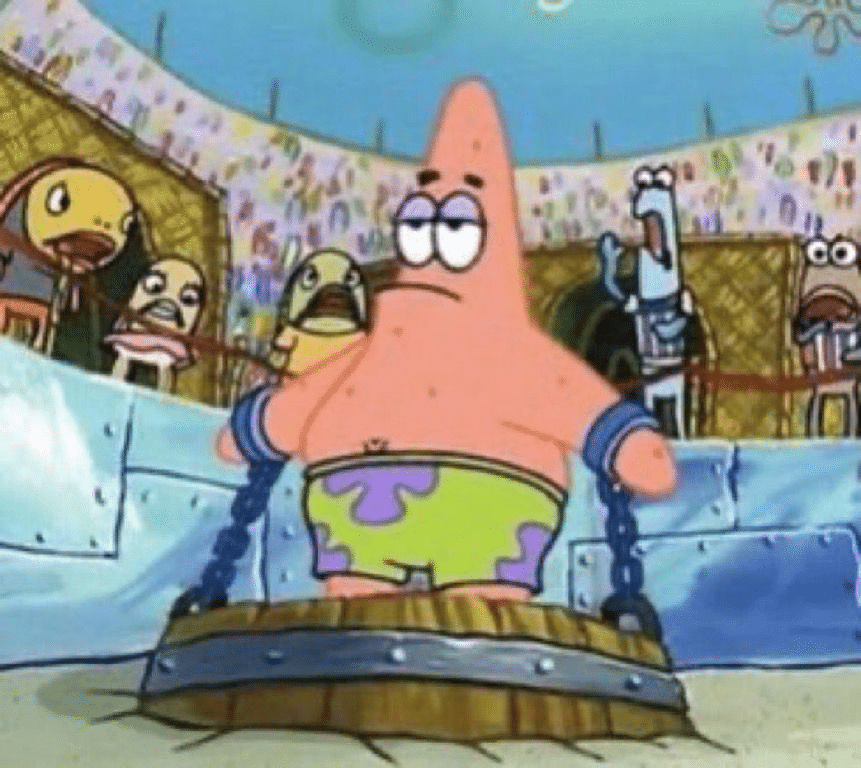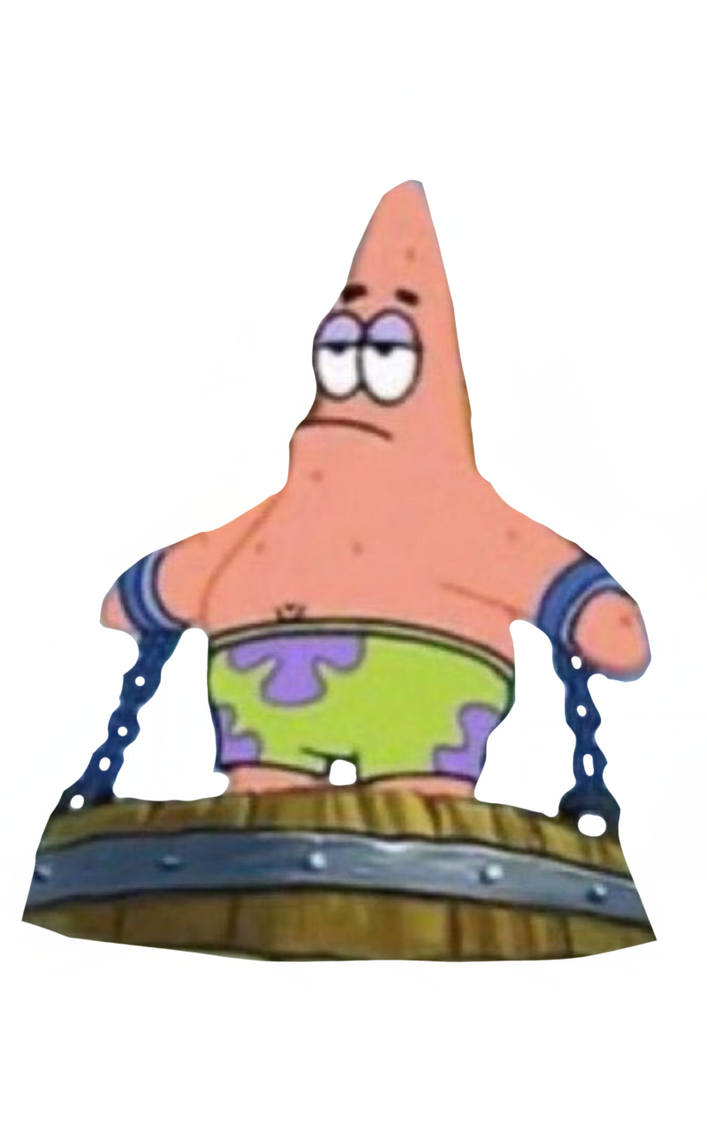Chained Patrick Meme: Viral Origins & Latest Trends | Google Discover
Is a cartoon character's plight in a meme a reflection of broader societal anxieties, or just another fleeting internet sensation? The enduring image of "chained Patrick" suggests that even the simplest visual concepts can capture complex emotions and resonate across diverse audiences.
The "chained Patrick" meme, a visual shorthand for frustration, confinement, and the expression of unpopular opinions, has unexpectedly woven itself into the fabric of online culture. Early iterations of this image, featuring the perpetually bewildered starfish from SpongeBob SquarePants, circulated in various contexts long before its recent surge in popularity. A November 18th, 2019, post on the subreddit \/r\/memeeconomy, for instance, paired the image with the villainous Mr. Krabs, highlighting the struggles of gamers. This early usage demonstrates the meme's adaptability, its ability to represent relatable experiences. The meme gained traction on a variety of platforms, with people finding their own personal uses for it.
The meme's appeal likely lies in its inherent flexibility. The image of Patrick, bound and seemingly on display, allows for the expression of vulnerability, the acknowledgement of constraints, and the sharing of potentially controversial ideas. This format, where Patrick is in the "middle of an arena" whilst fans voice their "unpopular opinions," offers a platform for satirical critique and self-deprecating humor. Theres an inherent irony in the situation; a cartoon character, known for his naivet and obliviousness, becomes the face of something that reflects modern sentiment.
The popularity of the "chained Patrick" meme can be contextualized through the emergence of similar trends. The enduring success of the "Are we the baddies?" meme, which originated on the British comedy show That Mitchell and Webb Look nearly 20 years ago, highlights the human tendency to question motives and behaviors. The image of the clueless characters, realizing they are, in fact, the villains, resonates with a self-aware cynicism that seems to have its roots in all forms of media, like the "chained Patrick" meme, which is also relevant. Such memes tap into anxieties surrounding accountability and moral ambiguity, and as such, continue to find audiences.
The meme's impact can also be seen in its merchandising. The Spongebob Squarepants Collection includes a vinyl figure of Patrick in chains, sold as the #28 figure in the series. The packaging clearly shows Patrick chained up in an arena as dozens of fish sit in the stands watching. The collectible figurine measures 5.1 inches tall and depicts Patrick on top of a wooden barrel with his arms out. The solemn expression on his face underscores the meme's capacity to transform humor into a statement about the human condition.
The meme has continued to gain traction, spreading and showing up in unexpected places. The memes format continues to evolve, with various iterations including a reference to the crucifixion of Jesus Christ. One instance compares Patrick chained up and being pelted with peanuts to the crucifixion. This speaks to the meme's ability to be utilized in different contexts, all while maintaining a central theme of vulnerability, frustration, and the experience of being unfairly judged.
- Exploring The Dynamic Duo Ed Westwick And Leighton Meester
- Dr Mireya Mayor Lips Surgery Transforming Smiles With Expertise
This widespread interest in the meme highlights its ability to capture the zeitgeist, encapsulating collective feelings with a simple visual. A look back at events like the viral sensation of the cash me ousside girl, which went viral eight years ago, indicates the ever-changing nature of internet trends, where memes rise and fall seemingly overnight. The "chained Patrick" meme, however, shows longevity, demonstrating an enduring ability to adapt and resonate with online communities. This adaptability is what allows the meme to remain relevant.
The "chained Patrick" meme, despite its cartoonish origins, offers a unique lens through which to examine internet culture. Its flexibility has allowed it to represent a wide variety of experiences and emotions. Its staying power is a testament to the power of simple visuals to reflect complex realities. It showcases the ways in which online communities create language and find their own distinct ways to communicate across a variety of platforms. It might be the best example of the evolving nature of meme culture.
It also emphasizes how internet trends, even those that seem trivial, can reflect and shape how we perceive the world around us. Its resonance proves that even when rooted in popular culture, these trends can evolve into relevant cultural conversations.
In a world inundated with information, a simple image of a cartoon character can become a symbol of something profound. In the current internet culture, where content moves rapidly, its rare for a meme to withstand the test of time. The chained Patrick meme continues to have a lasting impact.
It is a testament to how a simple image, even one from a cartoon, can become a meaningful cultural artifact. Its lasting impact demonstrates the power of memes to capture the human experience and resonate within the ever-changing digital landscape.
Beyond the meme itself, there are references to other topics such as the review of Patrick Cavanaugh's "The Wolfman Cometh", which demonstrates how the meme can be referenced across various media and forms of expression.
The meme's enduring power highlights the way in which users find unique ways to create language and express themselves. It is this flexibility that has allowed the "chained Patrick" meme to remain relevant within a world filled with a great deal of content.
Even as other trends emerge and fade away, the "chained Patrick" meme, with its simple visual, is proof that the internet has the power to create meaning from unexpected places.
The following table contains the data about the French journalist, Patrick Chne.
| Attribute | Details |
|---|---|
| Full Name | Patrick Chne |
| Born | April 26, 1956, Lyon, France |
| Nationality | French |
| Occupation | Journalist |
| Known For | Commentating on the Tour de France |
| Career | Worked primarily for France Tlvisions; commented on the Tour de France from 1989 to 2000. |
| Major Work | Commentary on Tour de France |
| Other Notable Work | Worked for France Tlvisions |
| Reference | Wikipedia |
- Is Simon Cowells Son Disabled Understanding The Truth Behind The Headlines
- Understanding The Legacy Of Meatloaf The Iconic Singer And Actor

Monkey D Luffy x Patrick Star Patrick Chained / What's An X Opinion

Meme Generator Patrick chained to barrel Newfa Stuff

Patrick chained by Walking With Dragons on DeviantArt